| Construction Rating: | starstarstarstar_borderstar_border |
| Flight Rating: | starstarstarstarstar_border |
| Overall Rating: | starstarstarstar_borderstar_border |
| Manufacturer: | West Coast Rocketry |
Brief:
Not too long ago, I won several kits from West Coast Rocketry on eBay. Not long after, I built my Screamer II, affectionately known as John Deer. Since my John Deere yellow and green paint cans have about one rocket left in them and I need the shelf space, I decided to build the Screamer which will be called the Jane Doe and painted with the contrasting paint scheme of the other one.
The Screamer is a basic 4FNC with a 29mm motor mount and a payload bay. The instructions are even more minimalist than those for the Screamer II and are printed in such fine print that reading them does not seem to be worth the effort.
Construction:
Construction began by marking the motor tube at 1/8" from one end and 3/4" from the other. The two centering rings were then epoxied in place. Both needed quite a bit of sanding to fit around the tube.
As I waited for the epoxy on the motor mount to set up, I turned my attention to the nosecone. It had a 3/4" diameter hole drilled to a depth of about 2". Into that hole, I was instructed to mount a lead fishing weight that came with the kit. I mixed some more epoxy, poured some in the hole, set the weight and then poured the remainder over the top.
The fin lines were marked on the BT with a butt template. They were then extended with an angle and 5" slots were cut out with a X-Acto knife.
With the fin slots cut, I test fitted the motor mount to find that it was going to need substantial sanding to fit either ring into the BT. The sanding was done and the mount was epoxied into place with the motor tube being flush with the aft end of the rocket. Epoxy was then used to fill space between the centering ring and the end of the BT.
After a long hiatus, I managed to put a little more work in on the Screamer. Using 5 minute epoxy, I glued one pair of fins in place. I filleted them with more epoxy using a gloved finger dipped into alcohol to smooth the fillets. These were allowed to set up overnight.
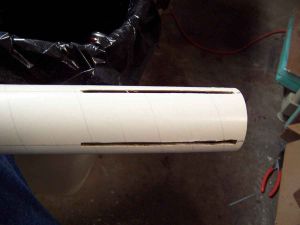
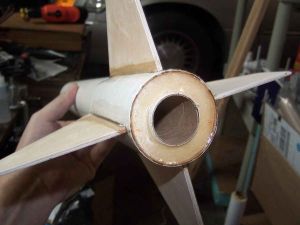
The payload bay is joined to the lower part of the rocket with a tube coupler. The kit comes with a plywood bulkhead to go on one end of the coupler and that is probably my biggest gripe about the kit. The bulkhead is a surface mount. I would much rather have had one that fits in the coupler. Be that as it may, I epoxied the bulkhead in place and tried to ensure that it was even with the edges.
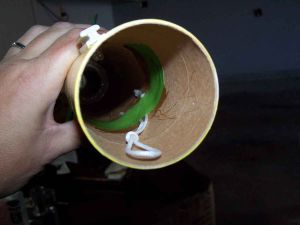 With the epoxy on the bulkhead coupler dry, I used some sandpaper to trim down the edges where they protruded past the coupler. When it fit easily into the body tube, I called it finished. I then took the screw eye and screwed it into the pre-drilled hole in the coupler. It seemed like a strong connection but I doused the pointed end with some glue to make sure.
With the epoxy on the bulkhead coupler dry, I used some sandpaper to trim down the edges where they protruded past the coupler. When it fit easily into the body tube, I called it finished. I then took the screw eye and screwed it into the pre-drilled hole in the coupler. It seemed like a strong connection but I doused the pointed end with some glue to make sure.
The coupler tube was marked at its halfway point and then a ring of glue was slathered into the base of the payload section. The coupler was then inserted to the mark and set aside to dry.
Finishing:
The balsa NC and plywood fins were sealed with Elmer's Wood Filler. It was sanded down smooth, dusted off, and the Screamer was put in the spray booth. There it was primed with Kilz.
After the priming, the rocket sat for a couple of months before I could give it any more attention. I then sanded down the primer and began painting with John Deere Yellow. My target was the BT. The fins and NC would be covered up later.
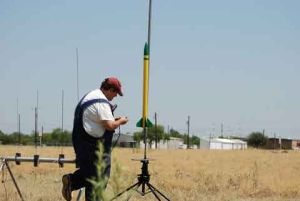 For the John Deere green, I decided to do the nose cone, a ring just below the nose cone, the fins and a narrow strip around the fins. The rocket was masked accordingly and sprayed. When the masking came off, I decided that I rather liked the result.
For the John Deere green, I decided to do the nose cone, a ring just below the nose cone, the fins and a narrow strip around the fins. The rocket was masked accordingly and sprayed. When the masking came off, I decided that I rather liked the result.
While assembling the rocket after painting, I realized that I had overlooked the recovery system. I would have like to have attached directly to the motor mount but that was a moot point now. I fashioned a LOC style mount with a loop of heavy nylon cord and some masking tape. It was taped down below the level of the NC shoulder and epoxy was slathered on to keep it in place. I then tied some heavy Kevlar® to the loop and attached a length of 3/8" sewing elastic.
One thing I did save intentionally for after painting was the installation of a linear rail lug. I put it is place and started the hole for the upper screw only to realize that I had placed it too high. It interfered with the payload bay coupler. I moved it down about an inch and found the same problem! I finally got it placed right and tapped the holes. The lug was then epoxied on and the screws inserted. The backs of the screws took up the remaining epoxy and the Jane Doe was ready to go.
Construction Rating: 3 out of 5
Flight and Recovery:
The first flight of this rocket took place long after construction had been completed. It was set up with an F25-4 and the Copperhead igniter that came with it. The Copperhead failed to ignite the motor and was replaced with a First Fire. That did the trick and the rocket took off with as nice a flight profile as I have ever seen. A video of the flight can be seen here.
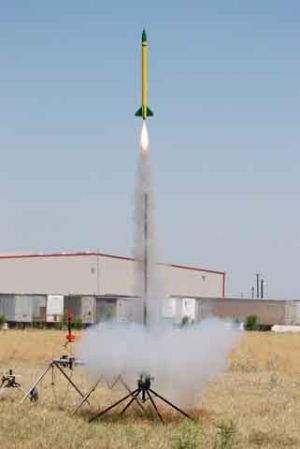 Ejection and deployment were all textbook. I expected to fly the rocket again but was mystified to see that it had suffered some buckling in the airframe. I can fix it but wonder what caused it since the thrust was not all that heavy.
Ejection and deployment were all textbook. I expected to fly the rocket again but was mystified to see that it had suffered some buckling in the airframe. I can fix it but wonder what caused it since the thrust was not all that heavy.
Flight Rating: 4 out of 5
Summary:
This was a very basic kit with a minimal approach to instructions, small print and illustrations that added little. That said, it went together fine and flew very well.
Overall Rating: 3 out of 5
Other Reviews
- West Coast Rocketry Screamer By Nick Hills
This is a single stage, Out-of-Production (OOP) mid and high power kit. This rocket is great for E-H motors. There are two (2) nicely finished 2.25" body tubes, same thickness as LOC's, a nicely turned solid balsa nose cone, four (4) 1/8" plywood fins, elastic for the shock cord (12 feet), a coupler, bulkhead, motor tube and two (2) centering rings along with a 1/4" launch lug. In my kit I ...
Sponsored Ads
 |
 |












